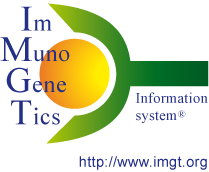Lysines and cysteines of the Homo sapiens IGHG1, IGKC and IGLC1 and positions in the C-DOMAIN
1. Structural and biological properties of human immunoglobulins
2. Human immunoglobulin (IG) chain characteristics
3. IG interchain disulfide bridges per monomer
5. Amino acid positions involved in ADCC, ADCP, CDC, half-life and half-IG exchange
6. IMGT engineered variant nomenclature: IGHG variants
7. Homo sapiens IGHG1 amino acids involved in the interactions with the C1q, FcγR and FCGRT
| C-DOMAIN strands, turns and loops | IMGT positions | Homo sapiens IGHG1 | Homo sapiens IGKC | Homo sapiens IGLC1 | ||
|---|---|---|---|---|---|---|
| CH1 | CH2 | CH3 | ||||
| A-STRAND | 1.5-15 | K1.1 | ||||
| K1.2 | ||||||
| K10 | ||||||
| K12 | K12 | |||||
| K15 | ||||||
| B-STRAND | 16-26 | K16 | ||||
| K18 | ||||||
| C23 | C23 | C23 | C23 | C23 | ||
| K26 | ||||||
| BC-LOOP | 27-38 | K38 | K38 | |||
| C-STRAND | 39-45 | W41 | W41 | W41 | W41 | W41 |
| K42 | K42 | |||||
| CD-STRAND | 45.1-45.5 | K45.4 | ||||
| D-STRAND | 77-84 | K79 | K79 | |||
| K81 | ||||||
| K82 | ||||||
| DE-TURN | 84.1-85.1 | K84.1 | ||||
| N84.4 | K84.4 | |||||
| K85.3 | ||||||
| E-STRAND | 85-93 | K88 | ||||
| V89 | L89 | L89 | L89 | L89 | ||
| K93 | K93 | |||||
| F-STRAND | 97-104 | K97 | ||||
| K98 | ||||||
| K100 | K100 | |||||
| K103 | ||||||
| C104 | C104 | C104 | C104 | C104 | ||
| FG-LOOP | 105-117 | K105 | ||||
| K109 | K109 | |||||
| K116 | ||||||
| G-STRAND | 118-127 | D118 | E118 | Q118 | T118 | E118 |
| K119 | K119 | K119 | K119 | K119 | ||
| K120 | ||||||
| K123 | ||||||
| K125 | ||||||
| CHS | K130 | |||||
| Nb of lysines | 6 | 12 | 7 | 8 | 9 | |
Positions are according to the IMGT unique numbering for C-DOMAIN [1]. For correspondence between the IMGT unique numbering with other numberings, see Correspondence between C numberings.
Sequences are from Homo sapiens IGHG1*01 (J00228), Homo sapiens IGKC*01 (J00241) and Homo sapiens IGLC1*02 (X51755).
In addition to the lysines are shown:
- the five characteristic amino acids of a C-DOMAIN [2,3]. Four of them are highly conserved and hydrophobic [4] and are common to the V domain: C23 (1st-CYS), W41 (CONSERVED-TRP), 89 (hydrophobic) and C104 (2nd-CYS) [5]. These four amino acids contribute to the two major features shared by the V and C domains: the disulfide bridge (between the two cysteines 23 and 104) and the internal hydrophobic core of the domain (with the side chains of tryptophan W41 and amino acid 89) [2,3]. The fifth position, 118 is diverse in the C-DOMAIN and is characterized as being an FG loop anchor (whereas it is conserved in the V-DOMAIN and represented by J-PHE 118 or J-TRP 118).
- the CH2 N84.4 site of N-glycosylation (IMGT Lexique Glycosylation) at the top of the DE turn. The asparagine N84.4 is part of a N-glycosylation motif NXS/T (NST in Homo sapiens IGHG1).
| [1] | Lefranc, M.-P., Pommié, C., Kaas, Q., Duprat, E., Bosc, N., Guiraudou, D., Jean, C., Ruiz, M., Da Piedade, I., Rouard, M., Foulquier, E., Thouvenin, V. and Lefranc, G. IMGT unique numbering for immunoglobulin and T cell receptor constant domains and Ig superfamily C-like domains. Dev. Comp. Immunol., 29, 185-203 (2005).PMID: 15572068 |
| [2] | Lefranc, M-P. Immunoglobulin (IG) and T cell receptor genes (TR): IMGT® and the birth and rise of immunoinformatics. Front Immunol. 2014 Feb 05;5:22. doi: 10.3389/fimmu.2014.00022. Open access. PMID: 24600447. |
| [3] | Lefranc, M-P. Immunoglobulins: 25 years of Immunoinformatics and IMGT-ONTOLOGY. Biomolecules. 2014, 4(4), 1102-1139; doi:10.3390/biom4041102. Open access. PMID: 25521638. |
| [4] | Pommié, C., Levadoux, S., Sabatier, R., Lefranc, G. and Lefranc, M.-P. IMGT standardized criteria for statistical analysis of immunoglobulin V-REGION amino acid properties
J. Mol. Recognit., 17, 17-32 (2004). PMID: 14872534 |
| [5] | Lefranc, M.-P., Pommié, C., Ruiz, M., Giudicelli, V., Foulquier, E., Truong, L., Thouvenin-Contet, V. and Lefranc, G. IMGT unique numbering for immunoglobulin and T cell receptor variable domains and Ig superfamily V-like domains. Dev. Comp. Immunol., 27, 55-77 (2003). PMID: 12477501 |
Last updated:
Authors: Karima Cherouali, Souphatta Sasorith and Marie-Paule Lefranc
IMGT Home page |
IMGT Repertoire (IG and TR) |
IMGT Repertoire (MH) |
IMGT Repertoire (RPI) |
IMGT Index |
IMGT Scientific chart |
IMGT Education |
IMGT Latest news ![]()



© Copyright 1995-2025 IMGT®, the international ImMunoGeneTics information system® | Terms of use | About us | Contact us | Citing IMGT

